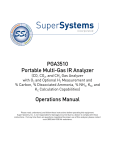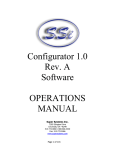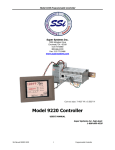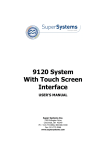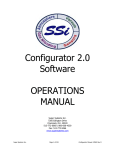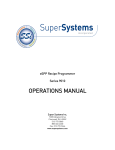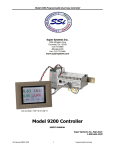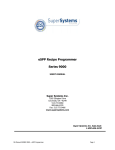Download Installation and Operating Instructions
Transcript
Installation and Operating Instructions (for chargers shown below) For additional information please call our Technical Support Group 800.742.2740 043009 PRO CHARGING SYSTEMS, LLC 1551 Heil Quaker Boulevard, LaVergne, TN 37086-3539 INSTALLATION AND OPERATING INSTRUCTIONS FOR THE FOLLOWING BATTERY CHARGING SYSTEMS: Model Name Model # Description Total Output Independently charge 12V Batteries in the following systems: Professional Series Uni Pro Dual Pro Tri Pro Quad Pro PS1 PS2 PS3 PS4 One 15 Amp Bank Two 15 Amp Banks Three 15 Amp Banks Four 15 Amp Banks 15 Amps 30 Amps 45 Amps 60 Amps 12V 12V, 24V 12V, 24V or 36V 12V, 24V, 36V or 48V Sportsman Series Uni Pro Dual Pro Tri Pro Quad Pro SS1 SS2 SS3 SS4 One 10 Amp Bank Two 10 Amp Banks Three 10 Amp Banks Four 10 Amp Banks 10 Amps 20 Amps 30 Amps 40 Amps 12V 12V, 24V 12V, 24V or 36V 12V, 24V, 36V or 48V IMPORTANT NOTICE Please save and read all safety, operating and installation instructions before installing or applying AC power to your on-board battery charging system. Please contact us with any product, installation, or service questions at technical support (800.742.2740). INTRODUCTION Pro Charging Systems, LLC (PCS) has been manufacturing waterproof, on-board battery charging systems since 1989. Our charging systems are designed and built tough to withstand intense vibration, extreme temperature variations and submersion without damaging the unit. Our systems use temperature compensation in order to fully charge a battery in hot or cold environments and are controlled by microprocessors in order to assure precise control over each totally independent charging bank. All of our chargers have true reverse polarity protection and shut off completely after each charge cycle. TABLE OF CONTENTS Important Safety Instructions.............................................................. Pages 2-3 Product Summary................................................................................Pages 4-5 Installation Instructions........................................................................Pages 5-6 Trouble Shooting.................................................................................Page 7 Warranty Information...........................................................................Page 8 IMPORTANT SAFETY INSTRUCTIONS Use of attachments not recommended or sold by PCS may result in a risk of fire, electrical shock, or injury to persons. To reduce risk of damage to the electrical plug and power cord, always pull by the plug rather than by the power cord when disconnecting charger. 2 When using an extension cord, make sure: 1. That pins on the extension cord plug are the same number, size and shape as those of the charger’s plug; 2. That extension cord meets UL (Underwriters Laboratories, Inc.) acceptance and is in proper operating condition; 3. That wire size is large enough for the ac ampere rating of charger. Do not operate charger with a damaged cord or plug—replace the cord or plug immediately. Do not operate charger if it has received a sharp blow, been dropped or otherwise damaged in any way; contact our technical support group for assistance (800.742.2740). Do not disassemble charger; contact technical support when service or repair is required. Incorrect reassembly may result in risk of electrical shock or fire. To reduce risk of electrical shock, unplug charger from outlet before attempting any maintenance or cleaning. WARNING: RISK OF EXPLOSIVE GASES 1. WORKING IN THE VICINITY OF A LEAD-ACID BATTERY IS DANGEROUS. Batteries generate explosive gases during normal battery operation. For this reason, it is of utmost importance that each time before using your charger, you read this manual and follow the instructions exactly. 2. To reduce risk of battery explosion, follow these instructions and those published by the battery manufacturer and by the manufacturer of any equipment you intend to use in the vicinity of battery. Review all cautionary markings on any product being utilized in or around the charging device. PERSONAL PRECAUTIONS Someone should be within range of your voice or close enough to come to your aid when you work near a lead-acid battery. Have plenty of fresh water and soap nearby in case battery acid contacts skin, clothing, eyes, or other surfaces. Wear complete eye protection and clothing protection. Avoid touching eyes while working near battery. If battery acid contacts skin or clothing, wash immediately with soap and water. If acid enters eye, immediately flood eye with running cold water for at least 10 minutes and seek medical attention. NEVER smoke or allow a spark or flame in the vicinity of a battery or engine. Be extra cautious to reduce risk of dropping a metal tool onto battery. This might cause a spark or shortcircuit a battery, possibly resulting in an explosion. Remove personal metal items such as rings, bracelets, necklaces, and watches when working with a lead-acid battery. A lead-acid battery can produce a short-circuit current high enough to weld a ring, or the like, to metal, causing a severe burn. Use charger for charging a LEAD-ACID (lead acid, sealed lead acid, gel cell, and AGM) battery only. It is not intended to supply power to a low voltage electrical system other than in a starter-motor application. Do not use battery charger for charging dry-cell batteries that are commonly used with home appliances. These dry cell batteries may explode, causing personal injury and damage to property. NEVER charge a frozen battery. 3 PREPARING TO CHARGE If it is necessary to remove the battery or batteries to charge, always remove grounded terminal from battery first. Make sure all accessories are off, so as not to cause battery arcing. Be sure the area around any battery is well ventilated while batteries are being charged. On occasion, “gas fumes” may be present during charging and can be forcefully blown away by using a piece of cardboard or other nonmetallic material as a fan. Proper ventilation is always recommended in the charging area. Clean all of the battery terminals. Be careful to keep corrosion from coming into contact with eyes. Add distilled water in each cell (wet cell batteries) until battery acid reaches level specified by battery manufacturer. This helps purge excessive gas from cells. Do not overfill. For a battery without cell caps, carefully follow manufacturer’s recharging instructions. Study all battery manufacturers’ specific precautions such as removing or not removing cell caps while charging and recommended rates of charge. Extension cords should be industrial grade/heavy duty UL approved and grounded. Check extension cord before use for damage, bent prongs and cuts. Replace if damaged. Always make your extension cord connection on the charger side first. After connecting the extension cord to the charger, proceed to plug the extension cord into a 120VAC GFCI protected (Ground Fault Circuit Interrupt) outlet. Always remove the extension cord from the 120VAC outlet first when charging is completed followed by unplugging the charger. PRODUCT SUMMARY General Operation: Use the following guidelines in this manual to install your fully automatic PCS battery charging system. Assure that the area around your charger and batteries is properly ventilated. Connect your extension cord with no AC power present to the battery charger and proceed to plug your extension cord in at a nearby 120VAC outlet. Once you plug in your PCS battery charging system, your batteries will be simultaneously and independently charged to 100%. Unlike systems that utilize one large charger to attempt to charge multiple batteries, your system utilizes a totally independent battery charger for each battery. Each charging bank will remain in a maintenance (“float”) stage once the battery is charged and then monitor and/or maintain the battery indefinitely provided that you leave your system plugged in, which is what we recommend. During the Float stage current will flow to the battery for 5 minutes and then shut off completely for 60 minutes. Your system provides an equalization stage every 30 days while plugged in. If the charger is normally disconnected from A/C after completing charge, equalization can be accomplished by plugging back into A/C whenever this stage is desired. Battery manufacturers recommend that equalization is done once a month in order to further reduce sulfation on the lead plates of a battery, which helps promote longer battery life. Note: During this process the LEDs will go through their normal routine(Red counting up for % of charge) and the Green Led will blink until the unit returns to the maintenance mode and a steady Green LED. (Not applicable to a Gel Profile) INDEPENDENT CHARGING BANK INDICATIONS When your battery charging system is activated, each bank provides charging information utilizing five red Light Emitting Diode (LED) indicators and one green Light Emitting Diode (LED) indicator. The five red LEDs enable you to track the progress of the charge cycle on each battery as the voltage rises. (see the following chart) 4 INSTALLATION INSTRUCTIONS All PCS battery charging systems are designed to be permanently installed in a well-ventilated area and have no mounting restrictions. Do not make any electrical connections to the power supply (AC) or to a battery (DC) until the installation process has been completed. If mounting the charger in a boat, please choose a flat surface as high above the water level as possible. If a compartment wall is chosen, make certain its strength is adequate to support the weight of the charger. Use the mounting flanges of the charger to mark locations for starter holes. Drill a 1/16 inch hole at each marked location. Then, utilize all stainless steel screws that have been provided and install the charger securely, being cautious not to over tighten the screws. Silicon sealer should be used to secure and waterproof the screw holes. IMPORTANT NOTICE The mounting brackets of the system may contain keyholes that are designed so that screws can be started before putting the charger into place. If applicable, the keyhole locations vary depending on which model you own. Before making any connections, prepare batteries as follows: (a) With caps securely in place, thoroughly clean the case and posts with a solution of baking soda and water. Be careful not to allow any baking soda to get inside the case. 5 (b) All posts, terminals, and connectors should be cleaned to a shiny bright finish, using a wire brush or sand paper. This should be done periodically to assure maximum conductivity between the battery and the charger. Each charge cable assembly is equipped with a temperature sensor located at the junction of each set of ring terminals. Attempts to shorten the cables could partially disable the charger. Therefore, we recommend that you do not make any adjustments without first consulting our technical support group at (800.742.2740). Proper cable extensions may be purchased in 5’, 10’, and 15’ lengths. See picture below. To connect the charger to the battery (batteries), route your charge cables from the charger to the batteries, being cautious to avoid sharp objects, and use the supplied wire ties to hold them securely and neatly in place. Securely attach each charge cable independently to one 12V battery by connecting the red (positive/+) lead ring terminal to the positive (+) battery post and the black (negative/-) lead ring terminal to the negative (-) battery post. See picture below: (-) (+) (-) (+) The charger pictured is a Professional Series Dual Pro, which has two independent 15 amp outputs. In addition, your charging system is supplied with an AC plug receptacle designed to hold the power cord plug when it is not being used. Locate a convenient site for the receptacle and attach it using the supplied four smaller stainless steel screws. Connect a heavy duty UL approved extension cord to the power cord of your charger and then plug the extension cord into a nearby 120VAC GFI protected (Ground Fault Circuit Interrupt) outlet. You should now observe a red LED indication on each bank of the charger representing each individual battery being charged. The voltage of each battery will reflect the number of LED indicators illuminated. When charging is complete, remove the extension cord from the 120VAC outlet first and then unplug the charger. 6 TROUBLE SHOOTING PROBLEM: No LED indicators illuminate in any of the charger banks. Solution Sequence: Check the AC power supply from its source through all connecting points up to the charger by using a meter or test light to confirm that current is being delivered to the charger. PROBLEM: One red LED indicator flashing. Solution Sequence: With the AC power supply cord unplugged, check the ring terminals for correct polarity (Red to positive or +) and (Black to negative or - ). Also check for corrosion free secure connections to the batteries. Check in-line fuses in charge cable for any signs of opening or corroded connections. Call the technical support group for further assistance (800.742.2420). PROBLEM: The LED indications change rapidly back and forth from red to green or the green LED will not illuminate after excessive charging time (16 hours or more). Solution Sequence: Disconnect AC power to the charging system. On multi bank chargers, remove the charge cable assembly of the affected bank from the battery and attach it to another battery in the boat. Take the original charge cable assembly from this battery and attach it to the battery from which you removed the first cable. Plug the charger in and observe the LED indications. If the rapid LED sequence (red to green repeatedly) occurs on a different bank of the charger, this confirms the existence of a battery problem. On single bank systems, simply try the charger on another battery. If the charger now operates normally (steady red LEDs or changes to green and holds), this indicates a possible problem with the original battery. If the same bank continues to malfunction, please call our technical support group (800.742.2740). PROBLEM: A green LED was illuminated before disconnecting the power from the charger, but upon reconnection, red LEDs appear and remain on. Solution Sequence: This is normal operating procedure for the system and simply indicates that a reanalysis of the battery status has been initiated and after a series of steps, the green LED will illuminate. PROBLEM: Two red LED indicators flashing. Solution Sequence: This indicates a Forming Stage timeout and alerts the user that the battery voltage has not risen above an acceptable limit within 3 hours. Battery should be tested. PROBLEM: Three red LED indicators flashing. Solution Sequence: This indicates that the charger has exceeded the maximum amount of time allowed for charging the battery. Battery should be tested. PROBLEM: Four red LED indicators flashing. Solution Sequence: This indicates that the internal temperature of the charger has exceeded allowable limits and this bank of the charger has shut down. If charger is in a closed compartment, open compartment doors and allow charger to cool for 8 hours. After this period, connect the charger to AC and begin charging again. 7 LIMITED WARRANTY Pro Charging Systems, LLC (PCS) makes this Limited Warranty only to the original retail purchaser. PCS warrants this battery charger for three years from the date of retail purchase against defective materials and/or workmanship. If such defects should occur, this unit will either be repaired or replaced at the discretion of the manufacturer. It is the responsibility of the original purchaser to return the charger along with proof of purchase, transportation, and/or any mailing or handling charges prepaid to the manufacturer or its authorized representative. This limited warranty is void if the product is misused, improperly maintained, handled carelessly or incorrectly operated. Additionally, this warranty is void if the charger is disassembled, the charger’s charge cables are cut, the power cord is cut off, the charger is altered without authorization from PCS, the serial number is removed, or repair is attempted by anyone other than an authorized representative. PCS makes no other warranty other than this limited warranty and expressly excludes any implied warranty, including warranty for any incidental or consequential damages. This is the only expressed limited three year warranty authorized by PCS and does not authorize anyone to assume or make any other obligation towards the product other than this three year Limited Warranty. Some states do not allow limitation of incidental or consequential damages. This warranty gives you specific legal rights and you may also have other rights which vary from state to state. Please call Pro Charging Systems, LLC (800.742.2740) for full warranty information and/or service. Below are some of our other options in chargers and battery accessories. Call our technical support group for more detailed information or visit our web site www.dualpro.com. 8










